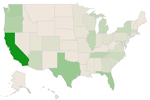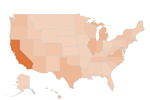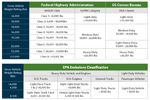Maps and Data
Find maps and charts showing transportation data and trends related to alternative fuels and vehicles.
OR
-
-
Light-Duty AFV, HEV, and Diesel Model Offerings, by Technology/Fuel
Trend of vehicle models incorporating various advanced technologies or alternative fuels, from 1991 through 2024 Last update May 2024
-
-
-
Electric Vehicle Charging Ports by State
Displays states and their respective EV charging port counts
-
-
-
U.S. Public and Private Electric Vehicle Charging Infrastructure
Trend of public and private electric vehicle charging infrastructure in the United States from 2011 to 2023 Last update March 2024
-
-
-
Electric Vehicle Laws and Incentives by State
Displays states and their respective law and incentive counts related to electric vehicles
-
-
-
U.S. Plug-in Electric Vehicle Sales by Model
Trend of sales by PEV model, 2011-2019 Last update January 2020
-
-
-
U.S. Private Electric Vehicle Charging Infrastructure
Trend of private electric vehicle charging infrastructure in the United States from 2007 to 2023 Last update March 2024
-
-
-
U.S. Public Electric Vehicle Charging Infrastructure
Trend of public electric vehicle charging infrastructure in the United States from 2007 to 2023 Last update March 2024
-
-
-
Efficiency Ratios for Light-Duty All-Electric Vehicles in the United States
Provides efficiency ratios of on-road all-electric vehicles in the United States in 2021, based on vehicle registration data. Last update September 2024
-
-
-
U.S. HEV Sales by Model
Trend of sales by hybrid electric vehicle (HEV) model, 1999-2019 Last update January 2020
-
-
-
Electric Vehicle Registrations by State
U.S. light-duty electric vehicle population as of December 2023 Last update September 2024
-
-
-
AFV and HEV Model Offerings, by Manufacturer
Trend of alternative fuel vehicle (AFV) and hybrid electric vehicle (HEV) models by manufacturer, 1991-2024 Last update October 2024
-
-
-
Change in U.S. Light-Duty Vehicle Registration Counts
Trend of light-duty vehicle registrations by fuel type, measured in percent change from 2016 through 2023 Last update June 2024
-
-
-
Share of All U.S. Vehicle Trips by Length (miles)
Breakdown of trip lengths among all vehicle trips Last update January 2024
-
-
-
Average Vehicle Trip Length by Purpose (2017)
Comparison of average vehicle trip length by purpose in the United States Last update October 2022
-
-
-
Clean Cities and Communities Coalition Locations
Displays coalition locations and boundaries across the United States Last update April 2024
-
-
-
Average Fuel Consumption at Increasing Road Grades
Trend of fuel consumption at increasing road grades, for various vehicle types Last update August 2014
-
-
-
TransAtlas
Interactive map displays light-duty vehicle registration counts over time by state and fuel type
-
-
-
Vehicle Weight Classes & Categories
Charts illustrate the vehicle weight classes and categories used by the Federal Highway Administration (FHWA), the U.S. Census Bureau, and the U.S. Environmental Protection Agency (EPA). Last update June 2012
-
-
-
Clean Cities and Communities Cumulative Energy Use Impact
Cumulative trend of reduced fuel use and increased fuel diversity from 1994 to 2022 Last update February 2024
-
-
-
Clean Cities and Communities Annual Energy Use Impact
Trend of reduced fuel use and increased fuel diversity from 1994 to 2022 Last update February 2024
-
-
-
Law and Incentive Additions by Fuel/Technology Type
Trend of state law and incentive enactments, listed by the targeted technology or fuel type, from 2002 to 2023 Last update June 2024
-
-
-
AFV Acquisitions by Regulated Fleets (by Fuel Type)
Trend of State & Alternative Fuel Provider (S&FP) alternative fuel vehicle (AFV) acquisitions by fuel type from 1992 to 2023 Last update June 2024
-
-
-
U.S. Public and Private Alternative Fueling Stations by Fuel Type
Trend of alternative fueling station counts by fuel type in the United States from 1992 to 2023 Last update May 2024
-
-
-
AFV Acquisitions by Regulated Fleets (by Fleet Type)
Trend of State & Alternative Fuel Provider (S&FP) alternative fuel vehicle (AFV) acquisitions by fleet type from 1992 to 2023 Last update June 2024
-
-
-
Clean Cities and Communities Energy Use Impact by AFV Type
Trend of energy impact by fuels used in alternative fuel vehicles (AFVs) from 2004 to 2022 Last update February 2024
-
Light-Duty AFV, HEV, and Diesel Model Offerings, by Technology/Fuel
| 1991 | 1992 | 1993 | 1994 | 1995 | 1996 | 1997 | 1998 | 1999 | 2000 | 2001 | 2002 | 2003 | 2004 | 2005 | 2006 | 2007 | 2008 | 2009 | 2010 | 2011 | 2012 | 2013 | 2014 | 2015 | 2016 | 2017 | 2018 | 2019 | 2020 | 2021 | 2022 | 2023 | 2024 | |
| Ethanol (E85) | 0 | 1 | 1 | 1 | 0 | 1 | 1 | 2 | 6 | 8 | 11 | 16 | 22 | 19 | 24 | 22 | 31 | 31 | 36 | 34 | 72 | 62 | 84 | 90 | 84 | 66 | 45 | 53 | 40 | 25 | 14 | 17 | 10 | 5 |
| CNG (Dedicated and Bi-Fuel) | 0 | 2 | 2 | 2 | 10 | 10 | 9 | 12 | 16 | 15 | 16 | 18 | 16 | 16 | 5 | 5 | 1 | 1 | 1 | 1 | 1 | 6 | 11 | 19 | 17 | 12 | 9 | 9 | 7 | 10 | 4 | 0 | 0 | 0 |
| Diesel | 17 | 14 | 5 | 12 | 13 | 12 | 11 | 11 | 7 | 3 | 3 | 4 | 4 | 7 | 8 | 6 | 7 | 6 | 12 | 14 | 16 | 17 | 22 | 35 | 39 | 29 | 21 | 38 | 30 | 20 | 25 | 22 | 22 | 20 |
| Electricity | 0 | 0 | 0 | 0 | 1 | 0 | 3 | 8 | 16 | 12 | 10 | 6 | 5 | 1 | 0 | 0 | 0 | 1 | 1 | 1 | 2 | 6 | 15 | 16 | 27 | 29 | 51 | 57 | 72 | 83 | 95 | 132 | 116 | 149 |
| Hybrid Electric | 0 | 0 | 0 | 0 | 0 | 0 | 0 | 0 | 0 | 2 | 2 | 3 | 3 | 3 | 8 | 8 | 11 | 16 | 19 | 20 | 29 | 31 | 38 | 43 | 46 | 31 | 44 | 43 | 64 | 81 | 127 | 149 | 127 | 143 |
| Propane (Dedicated and Bi-Fuel) | 0 | 0 | 0 | 0 | 0 | 0 | 3 | 3 | 5 | 2 | 5 | 5 | 1 | 1 | 0 | 0 | 0 | 1 | 1 | 0 | 0 | 1 | 6 | 14 | 10 | 5 | 8 | 7 | 7 | 8 | 4 | 0 | 0 | 0 |
| Hydrogen | 1 | 1 | 2 | 3 | 3 | 2 | 2 | 4 | 4 | 5 | 5 | 5 | 5 | |||||||||||||||||||||
| Methanol (M85) | 2 | 2 | 4 | 2 | 2 | 1 | 1 |
Source: Alternative Fuels Data Center (all years for AFVs); FuelEconomy.gov (all years for diesels, count all models and transmission types)
Notes: “Electricity" includes both all-electric vehicles and PHEVs but does not include neighborhood electric vehicles, low-speed electric vehicles, or two-wheeled electric vehicles. Only full-sized vehicles sold in the United States and capable of 60 mph are listed.
This chart shows the number of light-duty alternative fuel vehicles (AFVs), hybrid electric vehicles (HEVs), and diesel models offered by vehicle manufacturers from 1991 through 2024. Vehicles capable of using E85 (up to 85% ethanol, 15% gasoline) represented the largest share of models offered from 2003 until 2017, when electric vehicles (EVs, which include both all-electric vehicles and plug-in hybrid electric vehicles [PHEVs]) overtook them. This was largely because the technology required for E85 vehicles is comparatively inexpensive and compatible with gasoline vehicles. 2016 saw the first quantitative decrease in the number of new AFVs offered after 5 years of steady increases. Contributing factors to this decrease could be low gasoline prices, the Volkswagen diesel emissions scandal, and the phase-out of Corporate Average Fuel Economy (CAFE) credits for flexible-fuel vehicles (FFVs). Since then, increases in EV offerings have made up for and surpassed the loss in E85 offerings. AFVs increased year over year from 2016 until 2023, where it followed the overall decrease in all vehicle model offerings after the COVID pandemic saw record high demand for vehicles until 2022.
To view more details, notes, and acronyms, please download the Excel spreadsheet.
Print


























